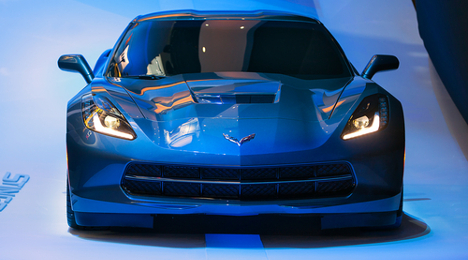NADA Outlines 1-Year-Old Mainstream Model Retention Rates

2015 Chevrolet Stingray
The December 2014 issue of the NADA Used Car Guide's Perspective featured part-two of its retention review, this time focusing on the value retention of several mainstream models, all of which were either all-new or heavily revised for the 2014 model year (see part one of the review, for luxury vehicles, here).
In the Retention Review, NADA used retention calculation based on a three-month average (October through December of 2014) of NADA’s average trade-in value divided by the vehicle’s typically equipped MSRP, sourced from data from ALG and the NADA Used Car Guide. The company noted that MSRPs provided do not include any incentives or rebates available at the time of purchase.
The following data was provided by the NADA via the December edition of Perspective.
2014 Upper Sports Car Average 1-Year Retention = 70.0 percent
- 2014 Chevrolet Corvette Stingray Coupe 1LT Automatic 1-Year Retention = 84.7 percent
- 2014 Chevrolet SS 6.2L V8 1-Year Retention = 71.6 percent
Sitting highest in retention rate after one year for all redesigned models is Chevrolet’s halo upper sport car, the Corvette Stingray. Despite its price increase of nearly 7 percent over its 2013 predecessor, the car’s price retention of 84.7 percent bested the previous year by an astounding 10.7 percentage points. The Corvette’s sport sedan brother, the Chevrolet SS, was all-new for 2014 and put up a decent retention rate of 71.6 percent, a 1.6 percent advantage over the segment’s average of a flat but still impressive 70.0 percent.
2014 Compact Utility Average 1-Year Retention = 68.9 percent
- 2014 Jeep Cherokee Sport 4WD 2.4L I4 1-Year Retention = 72.7 percent
- 2014 Mitsubishi Outlander SE 4WD 2.4L I4 1-Year Retention = 67.1 percent
- 2014 Nissan Rogue S AWD 2.5L I4 1-Year Retention = 73.1 percent
- 2014 Subaru Forester i Premium AWD 2.5L H4 1-Year Retention = 81.8 percent
2014 Sport Car Average 1-Year Retention = 67.9 percent
- 2014 Mini Cooper 1.5L I3 Turbo 1-Year Retention = 72.7 percent
2014 Midsize Utility Average 1-Year Retention = 67.6 percent
- 2014 Toyota 4Runner SRS 4WD 4.0L V6 1-Year Retention = 77.1 percent
- 2014 Toyota Highlander LE 4WD 3.5L V6 1-Year Retention = 78.8 percent
2014 Int. Compact Car Average 1-Year Retention = 65.2 percent
- 2014 Toyota Corolla L 1.8L I4 1-Year Retention = 70.4 percent
- 2014 Kia Forte Sedan EX 2.0L I4 1-Year Retention = 61.8 percent
- 2014 Mazda Mazda3 i Sport 2.0L I4 1-Year Retention = 68.7 percent
2014 Entry Subcompact Car Average 1-Year Retention = 64.8 percent
- 2014 Mitsubishi Mirage DE 1.2L I3 1-Year Retention = 54.5 percent
2014 Large Pickup Truck Average 1-Year Retention = 64.7 percent
- 2014 GMC Sierra Crew Cab SLE 4WD 5.3L V8 1-Year Retention = 72.7 percent
- 2014 Chevrolet Silverado Crew Cab LT 4WD 5.3L V8 1-Year Retention = 69.7 percent
Despite the Sierra’s $5,000 increase over the most popular model for 2013, the truck’s retention percentage increased by 7.2 percentage points, up from 65.5 percent, and also outpaced the segment’s retention by 7 percent. Following shortly behind was the Silverado, boasting a 6.2 percent increase in percentage points over 2013’s retention of 63.5 percent.
2014 Int. Subcompact Car Average 1-Year Retention = 62.4 percent
- 2014 Fiat 500L Pop 1.4L I4 Turbo 1-Year Retention = 55.3 percent
- 2014 Kia Soul + 2.0L I4 1-Year Retention = 56.5 percent
2014 Upper Midsize Car Average 1-Year Retention = 61.2 percent
- 2014 Kia Cadenza Premium 3.3L V6 1-Year Retention = 56.5 percent
2014 Int. Midsize Car Average 1-Year Retention = 61.2 percent
- 2014 Mazda Mazda6 i Sport 2.5L I4 1-Year Retention = 70.6 percent
2014 Large Car Average 1-Year Retention = 55.6 percent
- 2014 Chevrolet Impala LS 2.5L I4 1-Year Retention = 59.9 percent
Alone in it segment for redesigns, the 2014 Impala improved its retention rate over its 2013 predecessor by 9.1 percentage points (50.8 percent), but still fell far short of the segment’s average retention rate of 59.9 percent.
For more specific information regarding each of these models and their respective strengths/weaknesses, check out the NADA’s Perspective.

 View The Latest Edition
View The Latest Edition

